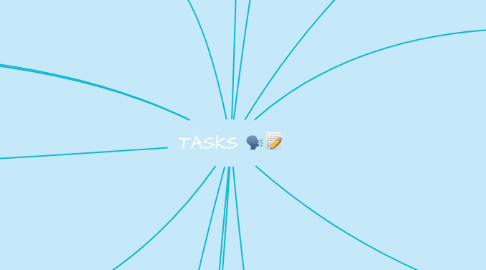
1. WHAT AREN'T THEY?
1.1. Activities that are concerned with language display
1.2. Actions with practice oriented 👩🏫 👀🧒
2. THESE ARE THE TWO MAIN TYPES
3. COMMUNICATIVE
3.1. They involve learners' in comprehending, manipulating, producing or interacting in the target language
3.1.1. Attention is focused on MEANING
3.1.2. Oral and Written activities are examples of them 🗣️📝 ✏️
4. LEARNING
4.1. They focus on formal features of the L2, and linguistic competence 🇺🇸
5. CLT AND TASKS
5.1. Learners use it not just to learn about the language 🇺🇸
5.2. Develop communicative competence 🗣️
6. HUMANISM AND TASKS
6.1. Schools were asked a more 'holistic' approach
6.2. Stevick identified 4 types of alineation for failure in teaching
6.2.1. Alineation for failure comes from:
6.2.1.1. the materials
6.2.1.2. themselves
6.2.1.3. the class
6.2.1.4. the teacher
7. SYLLABUS
8. STRUCTURAL
8.1. L2 acquisition is organic rather than 'additive'
8.2. Emphasis on early language production
9. PROCESS (Breen)
9.1. Learners and teachers create a 'process' which is not predesigned 🧑🏫 👨🏫👩🏫
9.2. Sharing the creation of the syllabus makes it all more meaningful and accessible 👏
10. WHAT ARE THEY?
10.1. Also know as 'ACTIVITIES' 📚
10.2. ACT OR ACTIONS that learners are given to process the language learning 🤓
11. THEY ARE ALSO DEFINED AS
11.1. Activities that include negotiation of meaning
11.2. They have an objective, context, procedure and outcomes for those who undertake the task
11.3. Activities or actions that are carried out to process or understand language
11.4. They may or may not involve production of the language
11.5. Activities which focus on meaning over form
12. GOOD TASKS
12.1. Encourage learners to attend to meaning 👏🏻
12.2. Give learners flexibility in solving problems in their own 🧑🏻🎓
12.3. Challenge but they are not demanding
12.4. Raise learners' awareness of the process of language use 🏥 🏭 🗣️ ✍🏻
13. PROCEDURAL (Prabhu)
13.1. Series of tasks which Ss did chosen and sequenced by the T
14. IN A LESSON 👨🏻🏫 🧑🏻🏫
14.1. PPP (Presentation, Practice, Production)
14.1.1. PRESENTATION --> New language is presented to the SS through elicitation 👩🏻🏫
14.1.2. PRACTICE --> SS are asked to practice the target language
14.1.3. PRODUCTION --> SS are encouraged to use the target language in a less controlled environment
14.2. CRITICISMS
14.2.1. Language is broken into small chunks
14.2.2. It does not reflect the nature of the language nor the learning
14.2.3. Transition from practice to production might not be sucessful
14.3. SKEHAN'S REASONS NOT TO QUIT ON THE PPP APPROACH
14.3.1. Comforting for the T 👨🏿🏫
14.3.2. Clear techniques such as elicitation or drilling
14.3.3. Clear goals
14.4. LANGUAGE LEARNING
14.4.1. ITEM LEARNING
14.4.1.1. Memorizing semi-fixed chunks 🧠
14.4.2. SYSTEM LEARNING
14.4.2.1. Discovering grammatical rules 🤯
